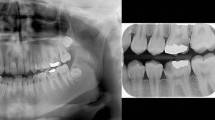Abstract
Aim The aim of this study was to establish the diagnostic efficacy of panoramic radiographs in six clinical situations for paediatric patients: caries, acute dental infections, dental trauma, dental anomalies, developmental disorders and pathological conditions.
Data sources The authors searched the following databases: Medline, Embase, the Cochrane Oral Health Group's Trials Register, the Cochrane Central Register of Controlled Trials, the Cochrane Database of Systematic Reviews, the Database of Abstracts of Reviews of Effects and the Cochrane Health Technology Assessment database. Forward citation searches of included studies were carried out. There were no language restrictions. The dates were restricted to include studies published between 1990-2018.
Study selection Inclusion criteria: children under the age of 18 for whom the diagnostic accuracy of panoramic radiography was compared to either clinical or an alternative radiographic examination for the six included indications. Exclusion criteria: panoramic radiographs taken for orthodontic indications outwith those stated in the aim. Studies of all designs were included. Screening of titles, abstracts and full texts were completed independently and in duplicate by two authors. Disagreement was resolved by discussion including a third author. A total of 3,420 abstracts were screened, from which 175 full texts were reviewed. Sixteen studies across the six indications were included in the review.
Data extraction and synthesis Data extraction was performed independently and in duplicate by two authors, with a third resolving disagreement. A standardised form was used which was initially piloted on ten papers. A narrative synthesis was carried out due to heterogeneity of the included studies precluding data synthesis.
Results Assessment of bias was completed using the QUADAS 2 tool. Of 16 included studies, the majority were of high or unclear risk of bias for domains including: patient selection, conduct or interpretation of the index test, reference standard, and patient timing and flow. Regarding detection of caries, one study was included which demonstrated clinical examination detected more carious surfaces than panoramic radiographs (6.0%, 95% CI 4.1-7.8%), but that bitewing radiography combined with panoramic radiography led to a higher diagnosis of approximal lesions than clinical examination alone by 4.3% (p <0.0001). Concerning acute dental infection, one study was included that did not present diagnostic accuracy data. Three studies related to dental trauma were included, all of which examined condylar fractures. Only one study reported diagnostic accuracy data: 70% diagnostic accuracy with panoramic radiography compared to 92% utilising CT scans. Four studies included examined diagnosis of a spectrum of dental anomalies. The only study to provide data on diagnostic accuracy reported a sensitivity of 50% for correct identification of supernumerary teeth on panoramic radiographs, with a specificity of 97.2%. Five included studies pertained to developmental disorders. One study gave data on diagnostic accuracy of panoramic radiographs. This showed sensitivity of 68.2% for identification of abnormalities in familial adenomatous polyposis. Two studies included were related to pathological conditions - one reported that panoramic radiographs gave 75% sensitivity to identify abnormal condylar morphology in patients with TMJ synovitis, with a specificity of 66.7%.
Conclusions The study concluded that more research is required concerning the diagnostic accuracy of panoramic radiographs for oral conditions in order to produce clinical guidance based on high-quality evidence.
This is a preview of subscription content, access via your institution
Access options
Subscribe to this journal
Receive 4 print issues and online access
$259.00 per year
only $64.75 per issue
Buy this article
- Purchase on Springer Link
- Instant access to full article PDF
Prices may be subject to local taxes which are calculated during checkout
Similar content being viewed by others
References
Whiting P F, Rutjes A W, Westwood M E et al. QUADAS-2: a revised tool for the quality assessment of diagnostic accuracy studies. Ann Intern Med 2011; 155: 529-536.
SDCEP. Prevention and Management of Dental Cares in Children: Dental Clinical Guidance. 2010. Available at https://www.sdcep.org.uk/wp-content/uploads/2013/03/SDCEP_PM_Dental_Caries_Full_Guidance1.pdf (accessed October 2020).
FGDP. Selection criteria for dental radiography - 4.2 Children. Available online at https://www.fgdp.org.uk/selection-criteria-dental-radiography/42-children (accessed October 2020).
Author information
Authors and Affiliations
Rights and permissions
About this article
Cite this article
Timms, L., Deery, C. Do panoramic radiographs offer improved diagnostic accuracy over clinical examination and other radiographic techniques in children?. Evid Based Dent 22, 110–111 (2021). https://doi.org/10.1038/s41432-021-0194-y
Published:
Issue Date:
DOI: https://doi.org/10.1038/s41432-021-0194-y



